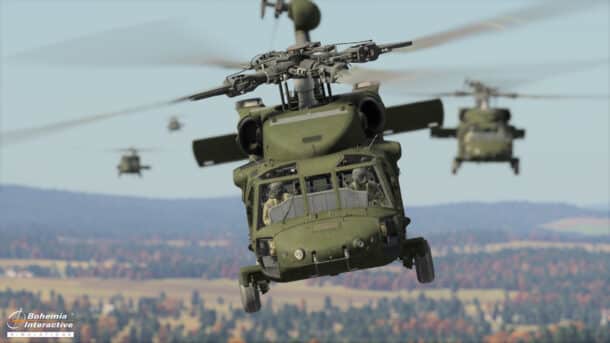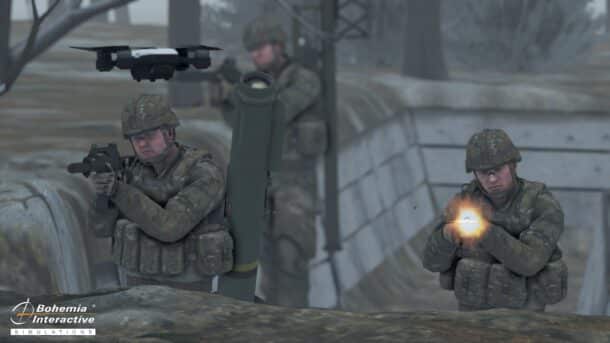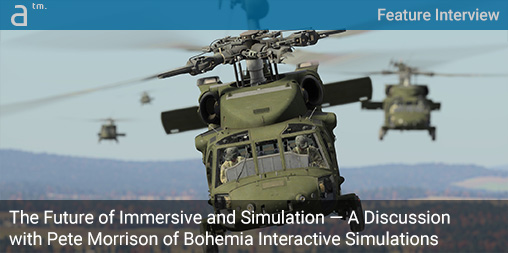APPLE’S VISION PRO HEADSET IS AN INFLECTION POINT in the technology domain we call “immersive technologies.” Rather than rushing to be first to market, Apple is well-known for leap-frogging the early incumbents of a new market. It did so with the iPod, iPhone, Apple Watch, and now the Vision Pro headset.
“I’m a 44-year-old,” says Pete Morrison, Chief Commercial Officer of Bohemia Interactive Simulations. “I would probably laugh at a person if I saw them walking down the street with a Vision Pro headset on, but that could be just around the corner. It doesn’t take much for culture to shift.”
It turns out that Morrison is quite correct. Speaking to Architosh before the Vision Pro got into customers’ hands, walking down the street with the new immersive technology is exactly what has transpired. And sure enough, the sight has inspired both laugher and nervousness.
The fundamental difference with our engine is we have built it from the ground up to meet very specific military requirements.
However, the Apple Vision Pro is likely the device that changes our cultural precepts about immersive technologies (VR, AR, MR/XR). More than a half-decade ago, virtual reality devices like the Oculus Rift were suddenly everywhere at computer trade shows, including in industries like architecture and construction. But the Gartner Hype cycle curve has forced its gravity on immersive tech just like all tech. A wave of entrants has collapsed down to just a few major players, and now the Vision Pro arrives in a moment to help drive immersive forward.
“If you think about Apple’s AirPods, they were so ugly, and people were laughing at how they looked, and now you see them every day, everywhere,” says Morrison, reminding me that all it takes is a killer app or use case. Suddenly, the technology takes off massively.
The Timing of Technology
Morrison knows technology cycles and the nature of timing. Sometimes, a market situation emerges, and a given company happens to have the right technology for it. That is the case for Bohemian Interactive Simulations, as its simulation, visualization, and virtual terrain technologies serve the United States Army and the militaries of its allies.
Founded originally as a computer gaming studio in the Czech Republic, with its impressive Operation Flashpoint military game, the simulation engine side of the company split off in 2007. It was purchased by private equity in 2012. And in 2022, it was acquired by global defense giant BAE Systems.

An image from Bohemia Interactive Simulations (BISim)’s remarkable physically accurate 3D environmental and physics-based simulation and terrain modeling digital tools used by the United States military and several of its NATO partners. BISim was acquired by the US-based component of the UK’s BAE Systems, a global defense industry giant. (click on the image for a larger view. ) (Image: BISim.)
BISim (shorthand for Bohemian Interactive Simulations) has the world’s most advanced simulation technologies. VBS4 delivers its customers the most advanced and complete virtual desktop training environment with whole Earth rendering for tactical training, mission rehearsal, and experimentation. The company’s simulation and terrain technologies also work hand-in-hand with Unity and Epic’s Unreal Engine.
“I would say that the military has always been looking for multiple engines depending on the problem they are trying to solve,” says Morrison. “The fundamental difference with our engine is we have built it from the ground up to meet very specific military requirements.”
With increasing global geopolitical challenges confronting the West and its allies, BISim’s world-class technologies were an obvious acquisition for a company like BAE Systems. The parent company delivers a comprehensive set of products and solutions across defense, aerospace, and security, including semiconductors used in military equipment.
Lessons from Ukraine
What the military is looking for in simulation engines that differ from the gaming industry boils down to both technical and customer service differentiation. “The military requires very long view distances in the simulation environment,” says Morrison, “plus very high frame rates and the ability to stream in terrain data for the entire planet.”
On the service side, Unity and Unreal Engine are busy serving hundreds of thousands of users. “I love Epic, by the way, but clearly, they have many priorities,” says Morrison. “Our military clients can reach us quickly.”

Lesson from Ukraine. BISim’s technology has been informed by lessons from the Russian invasion of Ukraine. Shown here is a simulation of a Ukrainian trench formation. (click on the image for a larger view. ) (Image: BISim.)
“Our big military customers require a service level agreement where we guarantee we can make the code changes they need, depending on what they are trying to do,” he adds.
BISim’s other key product is Mantle, its customizable terrain pipeline. This solution can ingest terrain, terrain-related data, and other data from multiple sources, including classified data.
Before Russia invaded Ukraine, the United States Army was already actively funding its next-generation terrain architecture. The Ukraine conflict just made it all the more apparent how important it was.
When Ukraine happened, the reason we were doing this became very clear. Ukraine really focused the GEOINT community.
Part of the Army’s goals included a requirement called “One World Terrain,” and Maxar ended up winning the contract related to providing that data. “Maxar is collecting satellite data and turning this into high-fidelity, photo-realistic 3D terrain, which is an amazing resource for both mission planning and simulation,” says Morrison.
“When Ukraine happened, the reason we were doing this became very clear,” he adds. “Ukraine really focused the GEOINT community.” The term “GEOINT” is a U.S. Army job description for a geospatial intelligence analyst. They are the ones we see in films pouring over real-time satellite imagery in military conflicts.
“So with Mantle, we can build and support all the things the GEOINT community needs and tie that all together,” he says. “I would say Ukraine added some momentum, but the U.S. Army was already well on this journey before Ukraine.”
SIM, Vision Pro, and Future Wars
BAE Systems, Inc., the U.S.-based headquarters of Britain’s BAE Systems, acquired BISim (Bohemia Interactive Simulations) for USD 200 million. While the purchase was finalized just a few weeks after Russia invaded Ukraine, BAE Systems Inc. had already done work with the U.S. Marine Corps.
Estimated at over USD 11 billion annually, the global simulation and training solutions industry is growing rapidly. This begs the question of whether or not Apple’s Vision Pro may play a critical role in future military simulation technology solutions. The Vision Pro has similar capabilities to Varjo’s XR4 headset.
If there is clarity—if you can see the real world and the overlays clearly—then the Apple Vision Pro would be a complete game changer in my industry.
The Finnish Varjo is the most advanced immersive headset creator in the world, with industrial-grade (not gamer-grade) capabilities. “We work with Varjo; their XR4 is currently considered the best mixed-reality (MR) headset in the market within my industry,” says Morrison. Training use cases for XR are still very limited,” he adds. It’s mostly just flight simulation and Forward Air Control training at the moment, but new headset technology is opening up possibilities.”
The U.S. Army has already run trials with Microsoft’s Hololens 2. The custom Hololens was for the Army’s IVAS program or Integrated Visual Augmentation System. “The challenges, as far as I am aware, are ergonomics and bright light,” he adds. “Bright light is a real pain when it comes to using augmented reality. Obviously, soldiers operate outside.”
MORE: NVIDIA Omniverse to now stream USD scenes to Apple Vision Pro
“If there is clarity—if you can see the real world and the overlays clearly—then the Apple Vision Pro would be a complete game changer in my industry,” says Morrison.
“The panacea for a soldier is a functioning augmented reality headset that isn’t uncomfortable, that allows them to overlay important information that could save their life.”
The EV Evolution, Batteries, and War
Wars are fought on land, sea, air, and space. BISim has simulation, visualization, and terrain solutions for every domain. This includes military flight training, where the company has already partnered with Varjo and its XR4 state-of-the-art headset.
When it comes to soldiers on land and the Army’s IVAS program, another critical issue, Morrison tells me, is weight. “Soldiers want to carry ammunition; they don’t want to carry batteries,” he says. How far batteries take a modified Hololens really matters. Even the Apple Vision Pro has limited battery life; a lot of innovation will be needed to figure out this problem.
What’s going to happen in the next battlefield—if it’s not happening already in Ukraine—is that the air will be so full of electronic noise that the drones will need to operate completely independently, and they won’t be able to communicate with a human.
When it comes to the future of war, programs like the Army’s IVAS are helping shape future military preparedness and impacting the technologies themselves. “Obviously, with this program, what matters is how powerful the computer on it is, how long the batteries last, ergonomics, and a million other things,” says Morrison.
When thinking about simulation being delivered to a soldier’s eyes via a headset, one can’t help but wonder how battery advancements in adjacent industries may drive innovation in this one. The EV industry, in particular, has billions being invested in electric battery technologies, and the West’s biggest rival, China, is largely at the forefront.
If China wins global EV and semiconductor supremacy, future computers and batteries in headsets similar to Apple’s Vision Pro or Microsoft’s Hololens may give Chinese soldiers decisive advantages over rivals in future conflicts. “All you need to do is put cameras on weapons and stream the input into a Vision Pro, and you allow a soldier to shoot around corners,” says Morrison. “And that is just one of hundreds of things made possible by XR headsets.”
AI and BISim
That last example is likely terrifying but not nearly as terrifying as military drone swarms powered by AI agents.
The use of drones in Ukraine’s war with Russia has been game-changing. This is a new area of technology that must be accounted for in military simulations, and BISim is more than up to the task. A drone is just another war object in terrestrial space. It can be simulated. However, the task will be challenging.
“What’s going to happen in the next battlefield—if it’s not happening already in Ukraine—is that the air will be so full of electronic noise that the drones will need to operate completely independently, and they won’t be able to communicate with a human,” says Morrison.

BISim is the world leader in global digital terrain technologies and their technologies encompass the entire Earth and its space. (click on the image for a larger view. ) (Image: BISim.)
He notes that the United States government has ethical concerns about drones killing humans when it comes to who is making the decision. Is it a human on the other end or a software AI? Morrison paints an alarming picture with these words: “The Chinese could have one guy controlling a thousand drones, whereas we have a thousand guys controlling a thousand drones.” All because the Chinese may not have the same ethical concerns about AI and drones as in the West.
Artificial intelligence (AI) is going to be an outcome-changing technology in the future of war. It will be a decisive agent at the highest strategy level down to a soldier’s real-time info—perhaps delivered inside a headset like the XR4, Vision Pro, or Hololens.
We will be able to see how potentially thousands of commanders solve tactical problems, the same tactical problem.
At the strategy level, BISim aims to simulate every aspect of war. “We are building out high fidelity, ‘deterministic AI,’ in support of training,” he says. “The AI needs to be given high-level behavior by an administrator, but they can figure out what fire positions to take, what vehicles to mount, etc., all on their own.”
Another interesting aspect of AI technology at BISim is that it differs from the AI you might begin seeing in military computer games. “Whether it is assault, retreat, or defense when our AI acts, it acts in what we call a ‘believable manner,’ and it works across any terrain,” he adds.
Morrison assures me that most computer game AI is neither of these things. It might appear believable, but appearances can mislead.
As noted earlier, the U.S. Army is working to build next-generation simulation architectures. Once rolled out, the STE, the Synthetic Training Environment, will enable dozens, if not hundreds, of battle simulations running on a unified system architecture, all connected back to a server.
“We will be able to see how potentially thousands of commanders solve tactical problems, the same tactical problem,” he says. The AI will then be able to learn and analyze how humans are making decisions and then be able to advise on real operational scenarios based on what it [the AI] has seen.
“That’s the first interesting thing that AI will contribute to STE and simulation technologies at BISim,” adds Morrison. The second is that AI will begin to train itself to be a better adversary when the military conducts these simulations.”
There is old wisdom that if you want to be a better tennis player, you should play against a better opponent. What works in tennis will also work in war. How exactly the U.S. Army will benefit from this wisdom and the use of AI is classified.
Closing Thoughts
While Apple’s Vision Pro likely will mark an inflection point in the advancement of immersive technologies in the general markets, one must realize that XR devices that merge reality with virtual and augmented realities will be critical, if not indispensable, technologies in the armed forces.
The new artificial intelligence, drone tech, and XR headset tech, I think, are all going to come together to provide new experiences that we can’t yet even dream of even now.
Bohemia Interactive Simulations (BISim) already provides aerospace solutions combined with Varjo’s XR4 device. The XR4 never competed against VR headsets like the Oculus Rift. Priced differently, the XR4 is more akin to the graphics workstations that SGI (Silicon Graphics Inc.) once delivered to the United States militaries along with major industrial clients like Ford and Boeing.
New technologies often emerge in high-priced niche markets first. Their leading edge continues to serve those markets while the “trailing edge” takes up additional new markets, like computer gaming—if we stick to the SGI example. If the trailing-edge market overtakes the leading-edge market in investment dollars and competition, eventually, those secondary players disrupt the initial players (innovators) in their own leading-edge markets.

A picture of a simulator plus Varjo XR headset at the IITSEC 2023 trade show and conference. (click on the image for a larger view. ) (Image: BISim.)
One of the things wars tend to bring is ground-breaking innovation and surprise developments. Apple’s Vision Pro is only sold in the United States, yet already the device as appeared in Russia. That was never supposed to happen.
Multiple groundbreaking innovations are happening simultaneously. Unlike the car, electricity, and telephone of the early 20th century, today’s groundbreakers, like AI, drones, and immersive headsets, dramatically converge and enhance each other. “The drone technology [used in Ukraine] and AI tech have caught me by surprise,” says Morrison, “and everyone, I think.”
“The new artificial intelligence, drone tech, and XR headset tech, I think, are all going to come together to provide new experiences that we can’t yet even dream of even now,” says Morrison. “And while it’s moving very quickly, at BISim, we are capable of also moving quickly to integrate these new developments because our defense and security clients will be demanding it.”



